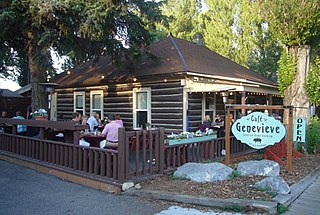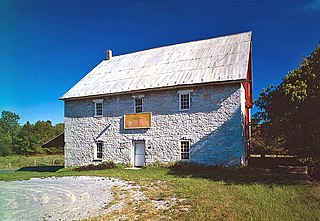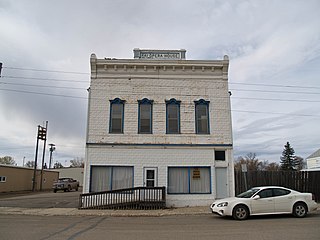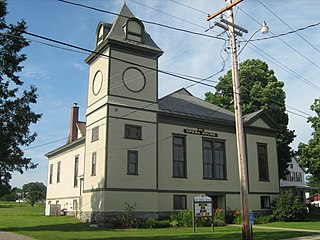
Death Valley Junction, more commonly known as Amargosa, is a tiny Mojave Desert unincorporated community in Inyo County, California, at the intersection of SR 190 and SR 127, in the Amargosa Valley and just east of Death Valley National Park. The zip code is 92328, the elevation is 2,041 ft (622 m), and the population is fewer than four people.
The Massie Variety Store is a historic commercial building located at 110 South Main Street in New Canton, Illinois. John Webb built the two-story brick Italianate building between 1848 and 1850 as a mercantile store. Webb sold the building to Amos Morey, who added Melville D. Massie as a partner; by 1872, Massie had become the store's only owner. The store became one of the largest in the region by the 1890s, and it had taken on other roles in the community. An opera house operated on the upper story from 1865 until the 1900s, and Massie served as an agent for local farmers who traded their products along the Chicago, Burlington and Quincy Railroad. Massie's son Harry began renting the storefront in 1918; in the following decades, it served as a drug store, ice cream parlor, grocery store, and post office before closing for good in 1948. Roger Dudley purchased the building from the Massie family in 1962 and converted it to a toy store; his business, later an antique store, operated until the 1980s.

Downtown Grand Forks is the original commercial center of Grand Forks, North Dakota, United States. Located on the western bank of the Red River of the North, the downtown neighborhood is situated near the fork of the Red River and the Red Lake River. While downtown is no longer the dominant commercial area of the Greater Grand Forks community, it remains the historic center of Grand Forks. An 80.4-acre (32.5 ha) portion was listed on the National Register of Historic Places in 2005, as Downtown Grand Forks Historic District. Today, downtown Grand Forks is home to many offices, stores, restaurants, and bars.

The Van Vleck House was built in Jackson, Wyoming in 1910–1011. The log house and barn are the only remaining residential structures in the vicinity of the Town Square.

The Newport Opera House is a historic civic building and performing arts venue at 20 Main Street in the heart of downtown Newport, the county seat of Sullivan County, New Hampshire, United States. Built in 1886, it was billed as having the largest stage in New England north of Boston, and continues to serve as a performance venue today. The building was listed on the National Register of Historic Places, as "Town Hall and Courthouse", in 1980, for its architecture and civic roles, and is a contributing property in the Newport Downtown Historic District.

The Bunker Hill Historic District is the center of the town of Bunker Hill, West Virginia. Today located on the road called US 11, the town was developed along the Martinsburg, West Virginia - Winchester, Virginia road. Bunker Hill served southern Berkeley County with three stores, six mills, and five churches. It was also home to a significant African-American population.

Ray Opera House is on Main Street in Ray, North Dakota.

The Woodsville Opera Building is a historic commercial and performance building at 67 Central Street in Woodsville, New Hampshire, the commercial center of the town of Haverhill. Built in 1890, it is a local architectural landmark, and includes a performance venue that has been used for many local events, including high school graduations and proms. The building was listed on the National Register of Historic Places in 1980.

The Wakefield Town Hall and Opera House is a historic municipal building at 2 High Street in the Sanbornville village of Wakefield, New Hampshire. Built in 1895, it is a prominent local example of Romanesque architecture, and has housed civic and social activities since its construction. The building was listed on the National Register of Historic Places in 2007, and the New Hampshire State Register of Historic Places in 2002.

The Newport Downtown Historic District encompasses the 19th century heart of Newport, New Hampshire, the county seat of Sullivan County. The district includes the major commercial and civic buildings which line Main Street between Depot Street and the Sugar River. The district was listed on the National Register of Historic Places in 1985.

The West Liberty Commercial Historic District in West Liberty, Iowa, United States, is a historic district that was listed on the National Register of Historic Places in 2002. At that time, it included 41 contributing buildings, six other contributing structures, and eight non-contributing buildings.

The Kucheman Building is a historic commercial building located in Bellevue, Iowa, United States. It is one of over 217 limestone structures in Jackson County from the mid-19th century, of which 20 are commercial buildings. The two-story structure was built in 1868 to house Kucheman & Son, a dry goods and clothing store. The second floor has housed an Opera Hall and City Hall. An addition was built onto the rear of the building sometime between 1902 and 1914. The building features four bays on its main facade, which is capped by a stone cornice with arched metal pediment. The stone blocks used in its construction vary somewhat in shape and size, and they were laid in courses. It also features dressed stone window sills and lintels. What differentiates this building from the others is its segmental arched windows. The second floor windows on the front have simple stone hoodmolds. The building was listed on the National Register of Historic Places in 1991.

Ossian Opera House, also known as the Knights of Columbus Hall, is a historic building located in Ossian, Iowa, United States. The opera house "movement" was active in Iowa from about 1870 to 1930. Numerous auditoriums and halls were built in towns large and small. Ossian is somewhat unusual for a small town in that its opera house was a single-use type of building, rather a mixed-use facility. The frame building with a gable roof was built in 1893 by the Ossian Hall Company. It features a three-part facade, with a central frontispiece that is flanked by side wings. The hall could seat 350 people. The local Knights of Columbus council, a Catholic fraternal organization, acquired the building in 1956, and renovated the building for their clubhouse. It was listed on the National Register of Historic Places in 1979.

Fairlee Town Hall, at 75 Town Common Road, is the municipal heart of Fairlee, Vermont. It was built in 1913 to a design by a local architect, replacing the old Fairlee Opera House, which was destroyed by fire in 1912. It is a fine example of Colonial Revival architecture, and is a focal point of the village center and the town's civic life. It was listed on the National Register of Historic Places in 2014.

The Enosburg Opera House is a historic performance venue and meeting space at 123 Depot Street in Enosburg Falls, Vermont. Built in 1892 by the B.J. Kendall Company, a prominent local employer, it has been used since then as a regionally prominent performance venue. It also serves as the site of Enosburg's town meetings. It was listed on the National Register of Historic Places in 1978.

The Dr. B.J. Kendall Company is a historic industrial facility at 228 North Main Street in the Enosburg Falls village of Enosburgh, Vermont. Built in 1880, it was for many years the site where "Kendall's Spavin Cure", a treatment for a horse ailment, was manufactured and marketed. This business was one of the town's economic successes, its owners contributing significantly to its architectural heritage. The building was listed on the National Register of Historic Places in 1993; as of 2016, it is standing vacant.

Parker's Opera House, also known as Opera House Store, Woolworth's and Parker Place, is a historic building located in Mason City, Iowa, United States. It was designed by the prominent Des Moines architect William Foster. Cousins H. G. and A. T. Parker built this structure as an opera house, which was the first one in the community. While it initially filled a need in Mason City, it was replaced by more modern theatres around the turn of the 20th century. The third floor was created in the building in 1909 when it was placed across the middle of the auditorium. The first floor initially housed a clothing store, and F. W. Woolworth Company occupied it beginning in the mid-1920s, and the upper floors housed the local offices of the Standard Oil Company at the same time. The two-story addition in the rear was built in the 1960s. The first floor was redesigned in 1997 for Central Park Dentistry. The upper floors were converted into apartments in 2013.

The J.R. Darling Store is a historic commercial building at 1334 Scott Highway in Groton, Vermont. It was built about 1895 on a site that has long housed commercial activity, and was the town's last general store. It was listed on the National Register of Historic Places in 2004.



















